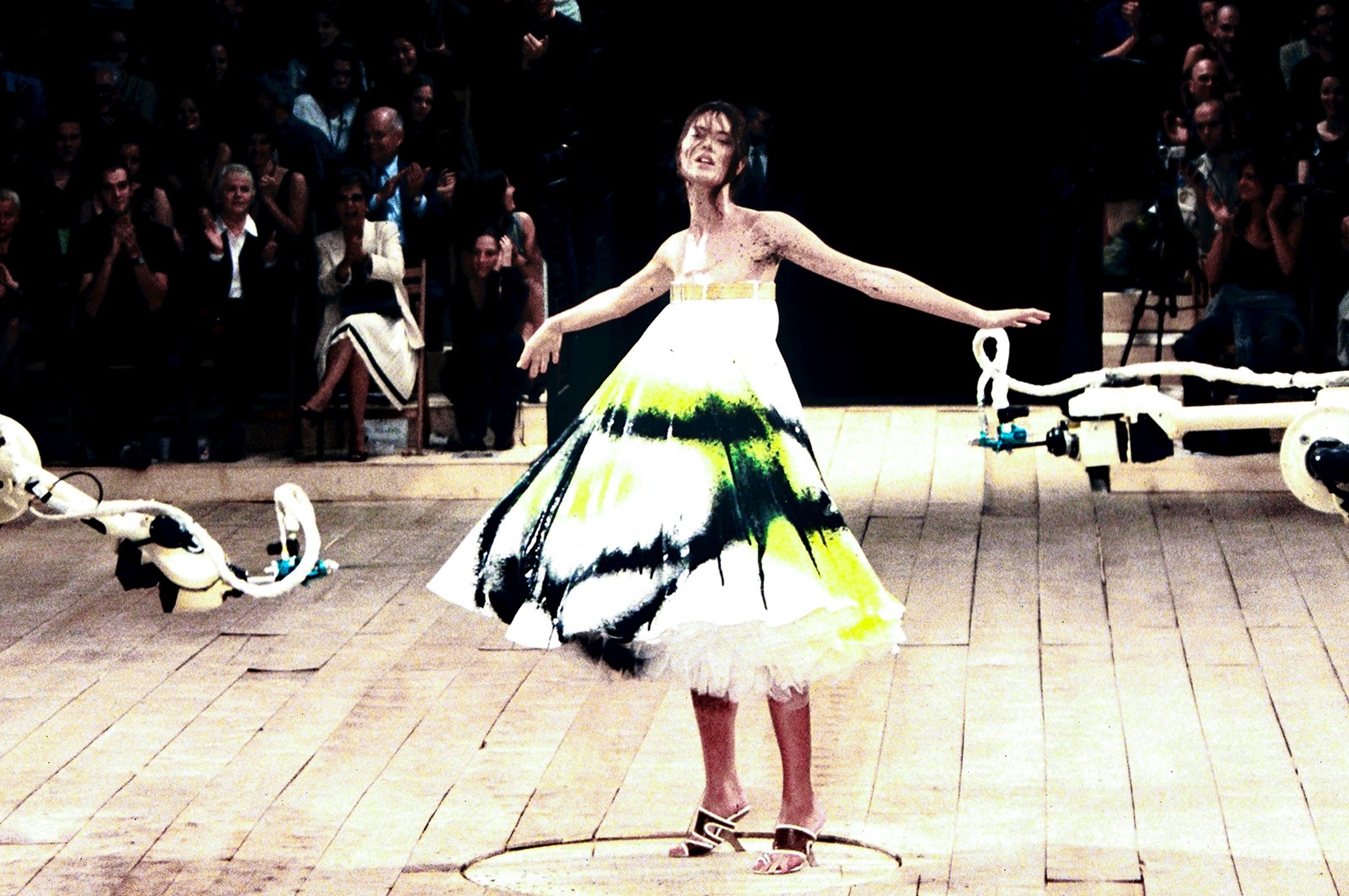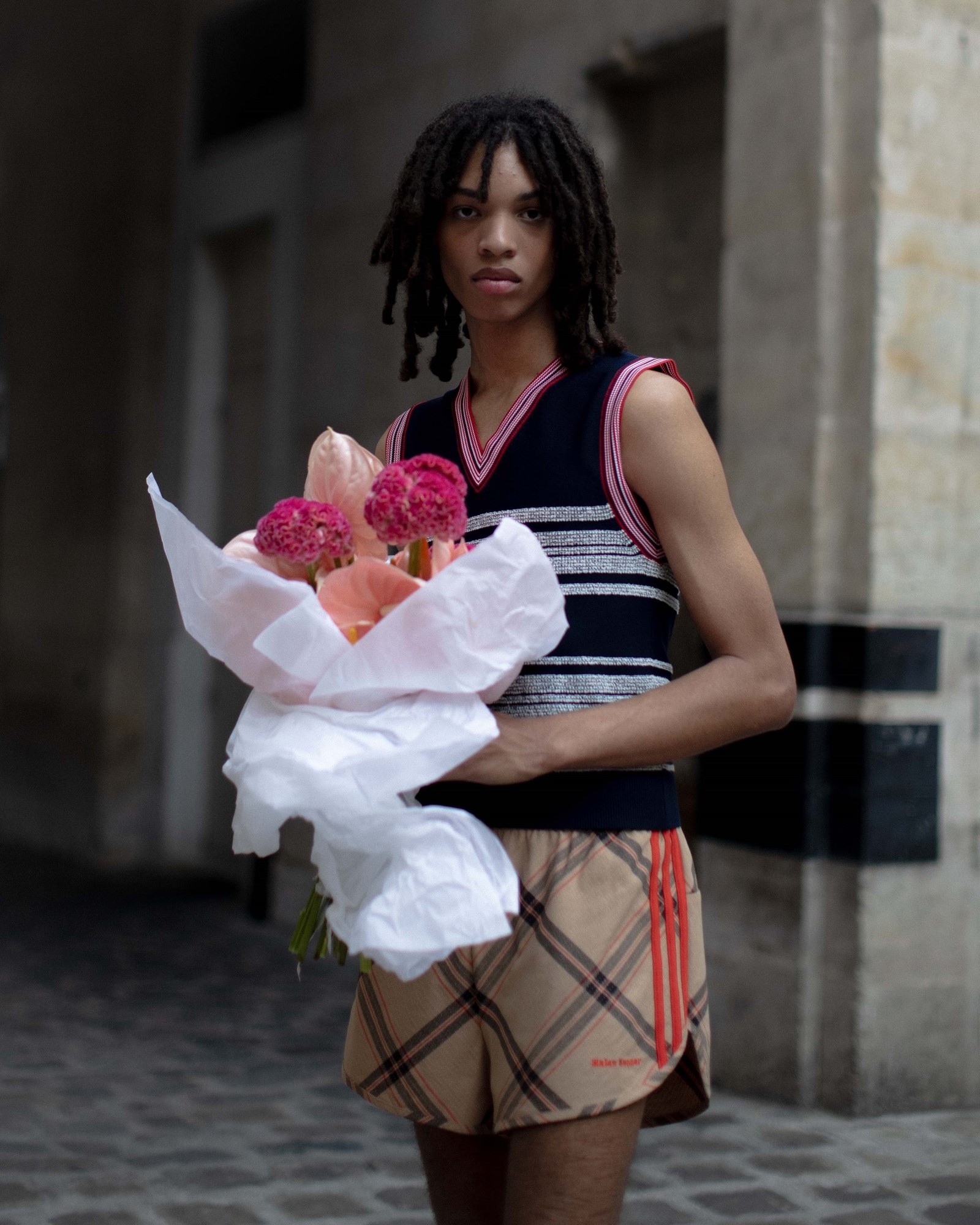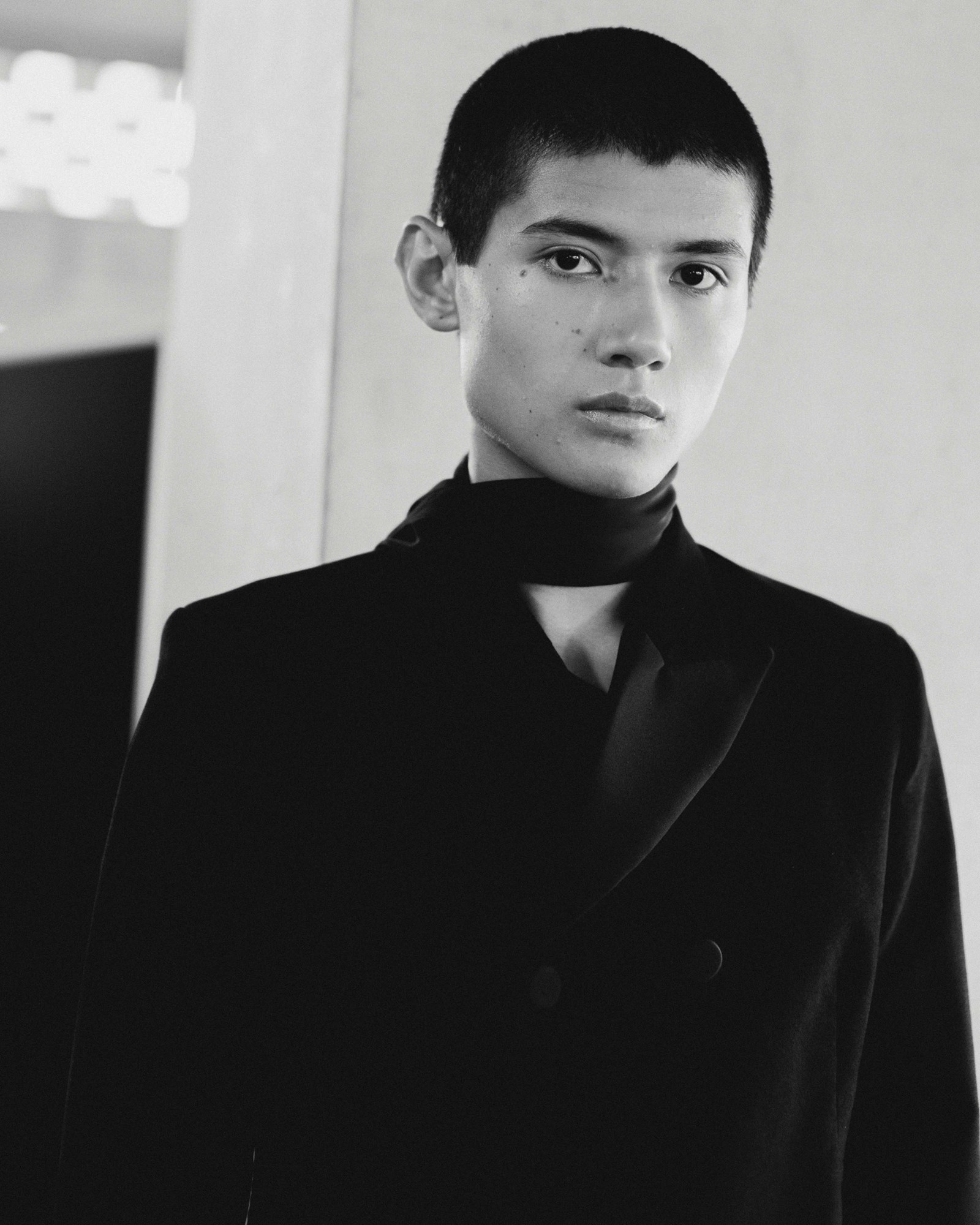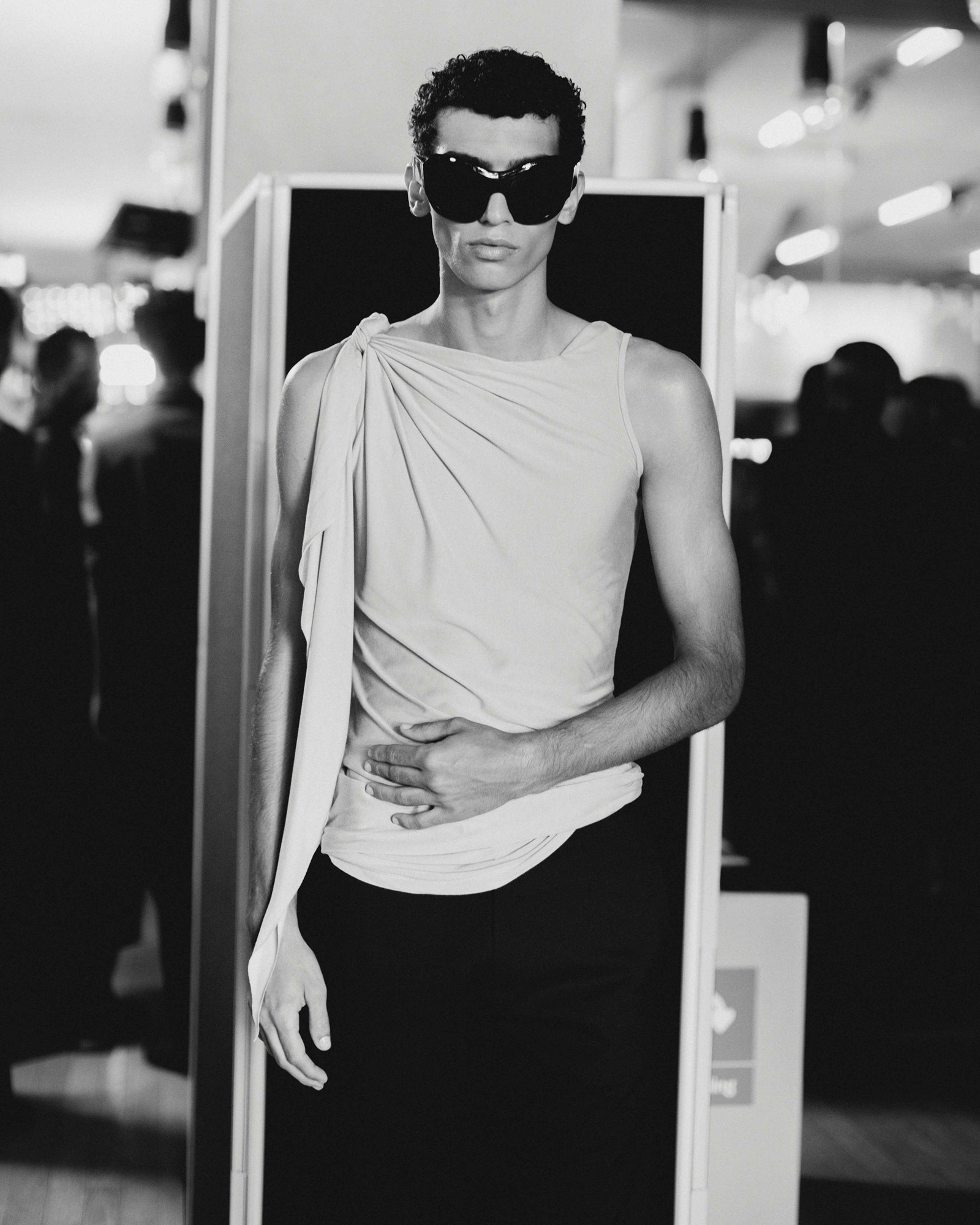Alexander McQueen’s shows are among the greatest ever staged, expanding the very concept of a traditional runway presentation. Unforgettable moments include a masked model encircled in a ring of fire for Joan (Autumn/Winter 1998), journalist Michelle Olley enclosed in a glass case covered in moths, naked but for a gas mask, for VOSS (Spring/Summer 2001), and of course, Shalom Harlow rotating on a wooden block as her white dress was spray-painted by two robots for No. 13 (Spring/Summer 1999). Later, more robots followed models throughout Plato’s Atlantis (Spring/Summer 2010), the first fashion show ever to be live-streamed. With an accompanying soundtrack that launched Lady Gaga’s Bad Romance, it duly broke the internet.
Two decades on, these images are still powerful, still provocative: they remain embedded in the fashion consciousness. Sam Gainsbury and Anna Whiting were central to the team behind them. After meeting McQueen in the mid-90s, they went on to produce all of his shows, transforming his often extremely challenging creative ideas into reality. Their business, Gainsbury&Whiting, is one of fashion’s foremost production companies, working with famed international luxury brands, but also emerging designers who are starting out, just like McQueen was, all those years ago.
The climate is different now – the welfare state is all but eroded, education is more expensive than ever, and the economy is challenging for even fashion’s biggest names let alone nascent talent. But Gainsbury+Whiting’s GW+ division is helping the latter in much the same way Gainsbury and Whiting did McQueen – “begging, stealing and borrowing” the resources necessary to achieve their goals. They work with Grace Wales Bonner (now not-so-emerging), Aaron Esh, Dilara Findikoglu, and Talia Byre, among others.
Times may be challenging, but the team at GW+ is showing a new generation of designers that, with the right support, it is still possible for creativity to triumph. Here, Gainsbury tells AnOther about working with McQueen, the spirit of that time, and how she’s striving to bring that same energy to the current moment.
Ted Stansfield: You first worked with Lee on The Hunger, is that right?
Sam Gainsbury: I actually first worked with him when I cast The Birds (Spring/Summer 1995). The first show I produced for him was The Hunger (Spring/Summer 1996) and that was in the British Fashion Council’s tent. It was a brilliant show but what was apparent was that it wasn’t enough for Lee. He needed to tell stories a different way, and not on a white raised runway, which everyone seemed to do at that particular time. So that was the last show we ever did on a white raised runway.
TS: What was your impression of him?
SG: He was really honest and funny and just really straightforward. He said what he thought and didn’t have a filter, but was incredibly charming and a really lovely person.
TS: What was it like working on his shows and producing them?
SG: Great, because there was an enormous amount of respect from Lee for the people that I was bringing and introducing him to. Everybody came from the film industry (DOPs, production designers, scenic companies, sound designers) and what was lovely was how immediately collaborative he became with them. It wasn’t a situation where he told people what to do; he would have an idea and ask people how to make that idea become reality, which is a really brilliant way to work with somebody.
TS: Was there a favourite show that you worked on?
SG: My favourite show was the robot show with Shalom [Harlow] (Spring/Summer 1999), simply because that’s when we realised we could do entertainment as well as fashion shows. From that show [onwards], we got addicted to some kind of gag, finale, or narrative. That show was the catalyst that made us think, well, we’re never doing anything normal again.

TS: Was that one quite challenging to produce?
SG: They were all really challenging because we had no budget, but again, why we opened GW+ is that it actually leads you down a path where you don’t have a choice but [have] to go with what you can afford. Sometimes that makes things a little bit more interesting because there’s a lot of begging, stealing and borrowing [involved], which is actually really good fun.
It became like a badge of honour at McQueen if someone got something for free. People would run in and say they’d managed to get our 600 seats for free from the seating company, but that their entire family was coming.
The materials we used were often very raw; the wooden floorboards for No. 13 were just rural ply that we got from a yard. We got the robots from a Renault factory and drove up to Manchester to get them. We didn’t really know how to use them but just stuck them in the floor. Then it was trial and error – Katy [England] was the test dummy and we had a go on her a couple of times.
That trial and error often led to something very beautiful, something that can never be replicated. Nothing was over-thought. Lee gave us a very clear vision of what he wanted it to look like and, even more so, what he wanted it to feel like.
For that show, he was very specific about the programming and he wanted the robots to feel slightly sinister, reptilian, like snakes dancing around her.
“[Lee McQueen] really genuinely did believe that everything was possible. He taught me that, and I try to do that with the people who work here” – Sam Gainsbury
TS: What did he teach you?
SG: You could never, ever say something was impossible. He would be so confused, because he really genuinely did believe that everything was possible. He taught me that, and I try to do that with the people who work here. When someone comes and says we can’t do that or something’s not possible, I find it really annoying because there is always a version of something if you can’t deliver exactly what they’re asking for. Lee taught me that everything is possible and not to be defeated, to just make something happen.
TS: I interviewed Judy Blame many years ago and he told me that poverty was his [creative] aphrodisiac and it reminds me of that.
SG: We really did find money from all over the place to pay for things. Everything was cash then. And everything was in envelopes. Anna Whiting’s forte was getting things for next to nothing. Everyone was so committed, nobody was earning any money. None of us charged Lee anything for probably the first ten years of his career. Not a penny. And that’s not just me, that’s lighting directors, production designers – everybody, which is unheard of now.
TS: I remember reading an interview with Lee and he said that a lot of his early collections were funded by his dole money. Now the welfare state has been stripped back so much that’s not really possible. How would you compare the climate of that time with the climate today?
SG: We could always manage to find some money from somewhere [back then] and I don’t think it’s as easy to do that nowadays. It’s definitely not easy for the team to find anything for free now. They try very hard, and we don’t charge for our services at GW+, but it’s much harder to get the team on board for free.


TS: So how is GW+ addressing this?
SG: By trying to come from the same place and not accepting no for an answer. We do it in exactly the same way as we did back then. We meet the designer at the beginning, they come up with the concept and we try and get as near to that as we possibly can. We like to take an element from [the concept] that is really good and help them to pursue it. Then we go for it. We don’t like to let them down. We don’t say things aren’t possible. What we like to do here is deflect, so they come up with ideas and then we go back to them and say, this is what we think you should do and it’s a fantastic, brilliant idea and we think we can probably pull this off with the funds that you can scrape together.
TS: Can you tell me about the roster of designers that you’re working with and how you choose them?
SG: There are so many different generations that work within the company and lots of different tastes as well. I was drawn to Dilara [Findikoglu] because we had worked with her many years ago. I like her attitude. I like the fact that she reminds me of that personality, which won’t give in. She has very clear ideas. She’s certain of what she wants and is very talented, so she was somebody that we wanted to work with. What’s lovely about Aaron Esh is that he’s somebody who contacted us because he was a fan of some of our work. Then he connected with one of the producers here. The great thing is, much like myself and Lee, Lucy has a really great relationship with Grace Wales Bonner and produces all her shows; they have this connection. When you get a producer that has a connection with a designer, they work the extra hours and go the extra mile because there’s a relationship there.
“We do it in exactly the same way as we did back then ... We don’t like to let [the designers] down. We don’t say things aren’t possible” – Sam Gainsbury
TS: Who has been the most gratifying designer to work with thus far?
SG: Grace is very special to us because we’ve worked with her for a long time, and every single show she does is so well-considered and so thought out. I love Aaron very much because I see certain parallels between him and Lee in terms of the background, the family. Who is it that comes? It’s his mum, dad, and his auntie, and his studio is beneath his auntie’s dry cleaners. He’s really determined to do this on his own terms and I find that very inspiring. And I think his clothes are beautiful.
TS: What is your hope for GW+?
SG: My hope is that we have a nice, constant stream of people coming through the company and that we’re able to help them. I’ve seen the hard work and know how hard it is for them to find the money. They all deserve to go on and do bigger and better things. That’s my dream: that they all go off and become superstars.
Find out more about Gainsbury&Whiting’s GW+ division here.
